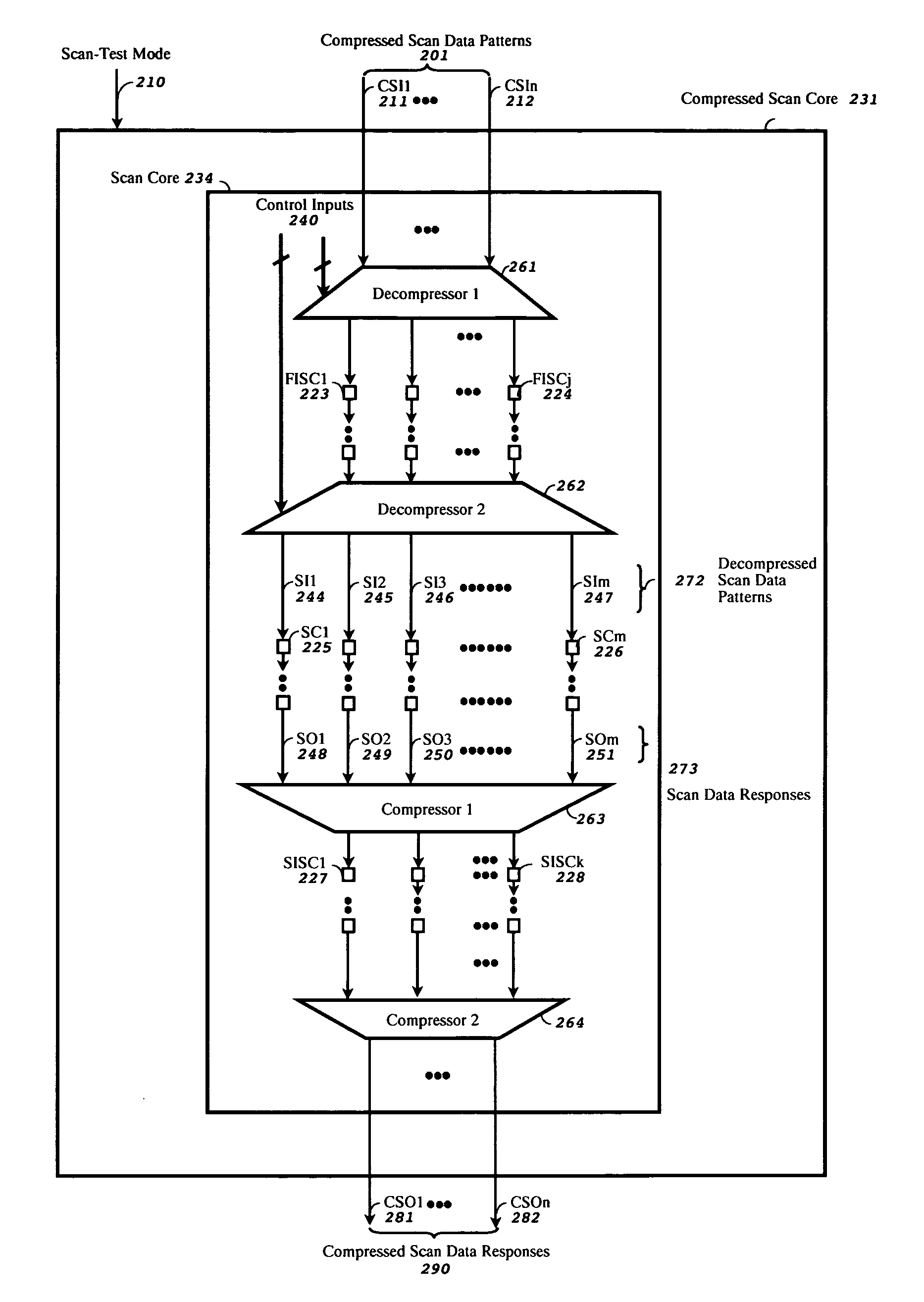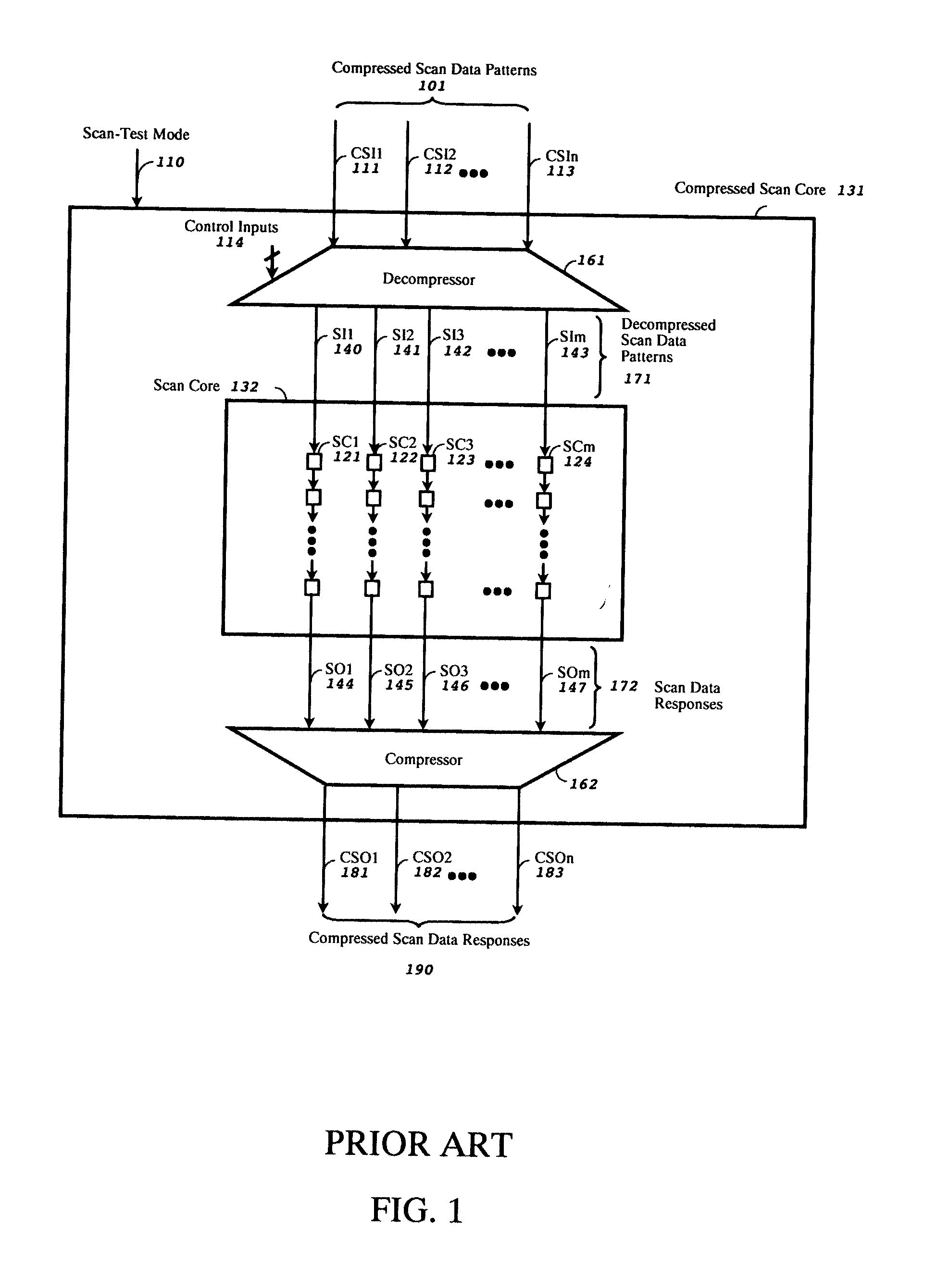Method and apparatus for multi-level scan compression
a multi-level scan and compression technology, applied in the field of logic design and test using designfortest (dft) techniques, can solve the problems of significant computational overhead, linear equations that cannot be solved, and scan compression techniques utilizing sequential decompressors such as lfsr circuits are difficult to use, so as to achieve better balance scan chains
- Summary
- Abstract
- Description
- Claims
- Application Information
AI Technical Summary
Benefits of technology
Problems solved by technology
Method used
Image
Examples
first embodiment
[0028]FIG. 2 shows a multi-level compressed scan test system, in accordance with the present invention, for testing scan-based integrated circuits. The Compressed Scan Core 231 comprises a Scan Core 234 with two decompressors Decompressor1261 and Decompressor2262 and two compressors Compressor1263 and Compressor2264 embedded in the Scan Core 234. The Scan Core 234 also comprises J First Intermediate Scan Chains FISC1223 to FISCj 224 embedded between Decompressor1261 and Decompressor2262, K Second Intermediate Scan Chains SISC1227 to SISCk 228 embedded between Compressor1263 and Compressor2264, and M scan chains SC1225 to SCm 226.
[0029] The Compressed Scan Core 231 further accepts a Scan-Test Mode 210 signal, and Compressed Scan Data Patterns 201 applied on external compressed scan inputs CSI1211 to CSIn 212 to drive the inputs of the first decompressor Decompressor1261, which also accepts Control Inputs 240 to control the Decompressor1261 during scan-test. The Decompressor1261 reads...
second embodiment
[0033]FIG. 4 shows a multi-level decompressor, in accordance with the present invention. The Decompressor 402 accepts Compressed Scan Data Patterns 401 and Control Inputs 404 to generate Decompressed Scan Data Patterns 403 by utilizing exclusive-OR (XOR) gates 405. The optional Control Inputs 404 are used to alter the relationship for different scan patterns, in order to improve fault coverage and fault diagnosis.
third embodiment
[0034]FIG. 5 shows a multi-level decompressor, in accordance with the present invention. The Decompressor 502 accepts Compressed Scan Data Patterns 501 and Control Inputs 504 to generate Decompressed Scan Data Patterns 503 by utilizing multiplexor (MUX) gates 505. The optional Control Inputs 504 are used to alter the relationship for different scan patterns, in order to improve fault coverage and fault diagnosis.
[0035]FIG. 6 shows a first embodiment of a multi-level compressor, in accordance with the present invention. The Compressor 602 accepts Scan Data Responses 601 to generate Compressed Scan Data Responses 603, by utilizing exclusive-OR (XOR) gates 604. A compressor utilizing an X-tolerant XOR network, having at least one internal scan chain output connected to two or more XOR gates, is also included within the scope of this invention.
[0036]FIG. 7 shows a flow diagram of a method for synthesizing two or more decompressors in either RTL (register-transfer level) or gate-level, ...
PUM
 Login to View More
Login to View More Abstract
Description
Claims
Application Information
 Login to View More
Login to View More - R&D
- Intellectual Property
- Life Sciences
- Materials
- Tech Scout
- Unparalleled Data Quality
- Higher Quality Content
- 60% Fewer Hallucinations
Browse by: Latest US Patents, China's latest patents, Technical Efficacy Thesaurus, Application Domain, Technology Topic, Popular Technical Reports.
© 2025 PatSnap. All rights reserved.Legal|Privacy policy|Modern Slavery Act Transparency Statement|Sitemap|About US| Contact US: help@patsnap.com



